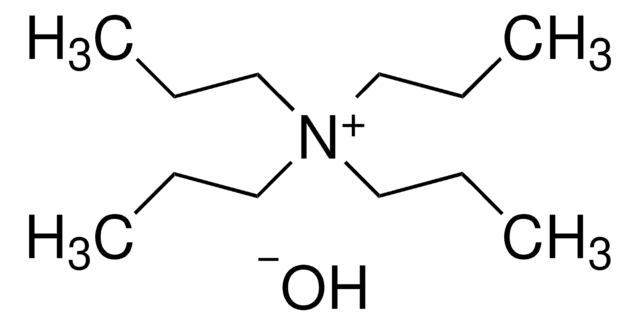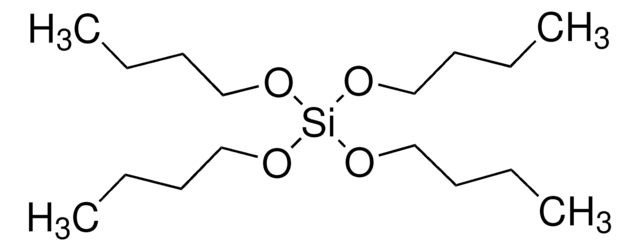131903
Tetraethyl orthosilicate
reagent grade, 98%
Synonym(s):
Orthosilicic acid tetraethyl ester, Silicon tetraethoxide, TEOS, Tetraethoxysilane, Tetraethoxysilicon(IV), Tetraethyl silicate
About This Item
Recommended Products
grade
reagent grade
Quality Level
vapor density
7.2 (vs air)
vapor pressure
<1 mmHg ( 20 °C)
Assay
98%
form
liquid
refractive index
n20/D 1.382 (lit.)
bp
168 °C (lit.)
density
0.933 g/mL at 20 °C (lit.)
SMILES string
CCO[Si](OCC)(OCC)OCC
InChI
1S/C8H20O4Si/c1-5-9-13(10-6-2,11-7-3)12-8-4/h5-8H2,1-4H3
InChI key
BOTDANWDWHJENH-UHFFFAOYSA-N
Looking for similar products? Visit Product Comparison Guide
General description
Application
- As an anti-solvent to fabricate efficient perovskite layer for inverted planar solar cells with enhanced power conversion efficiency and reproducibility. TEOS helps to achieve high-quality perovskite films with reduced density of defects, and thus slower carrier recombination.
- As a sol-gel precursor to synthesize SiO2-TiO2 anti-reflective self-cleaning coatings for solar cells.
- To fabricate nano silica functionalized crosslinked hybrid membranes for proton exchange membrane fuel cell applications. These membranes have better proton conductivity and thermal stability.
- To prepare poly(vinylidene fluoride)/TEOS matrix separator to enhance the performance of Li-ion batteries. The separator exhibits excellent electrolyte retention and wettability.
Features and Benefits
- Excellent adhesion on substrates
- Uniform film deposition
- Cross-linker to introduce polymer strands into hydrogel
Signal Word
Warning
Hazard Statements
Precautionary Statements
Hazard Classifications
Acute Tox. 4 Inhalation - Eye Irrit. 2 - Flam. Liq. 3 - STOT SE 3
Target Organs
Respiratory system
Storage Class Code
3 - Flammable liquids
WGK
WGK 1
Flash Point(F)
113.0 °F - closed cup
Flash Point(C)
45 °C - closed cup
Personal Protective Equipment
Choose from one of the most recent versions:
Already Own This Product?
Find documentation for the products that you have recently purchased in the Document Library.
Customers Also Viewed
Articles
Silica is a very popular inorganic nanomaterial used in a wide range of applications including fillers for rubber, catalyst supports, separation media, carriers in food and agriculture, and abrasive/anticaking agents in cosmetics. It is also widely believed to be an important material for biomedical applications for following reasons.
Magnetism and magnetic materials have been of scientific interest for over 1,000 years. More recently, fundamental investigations have focused on exploring the various types of magnetic materials and understanding the magnetic effects created by electric currents.
Synthesis of Melting Gels Using Mono-Substituted and Di-Substituted Alkoxysiloxanes
The properties of many devices are limited by the intrinsic properties of the materials that compose them.
Global Trade Item Number
| SKU | GTIN |
|---|---|
| 131903-4L | 4061838252067 |
| 131903-500ML | 4061838252074 |
| 131903-2.5L | |
| 131903-1L | 4061838252036 |
| 131903-25ML | 4061838252050 |
| 131903-5ML | |
| 131903-250ML |
Our team of scientists has experience in all areas of research including Life Science, Material Science, Chemical Synthesis, Chromatography, Analytical and many others.
Contact Technical Service












